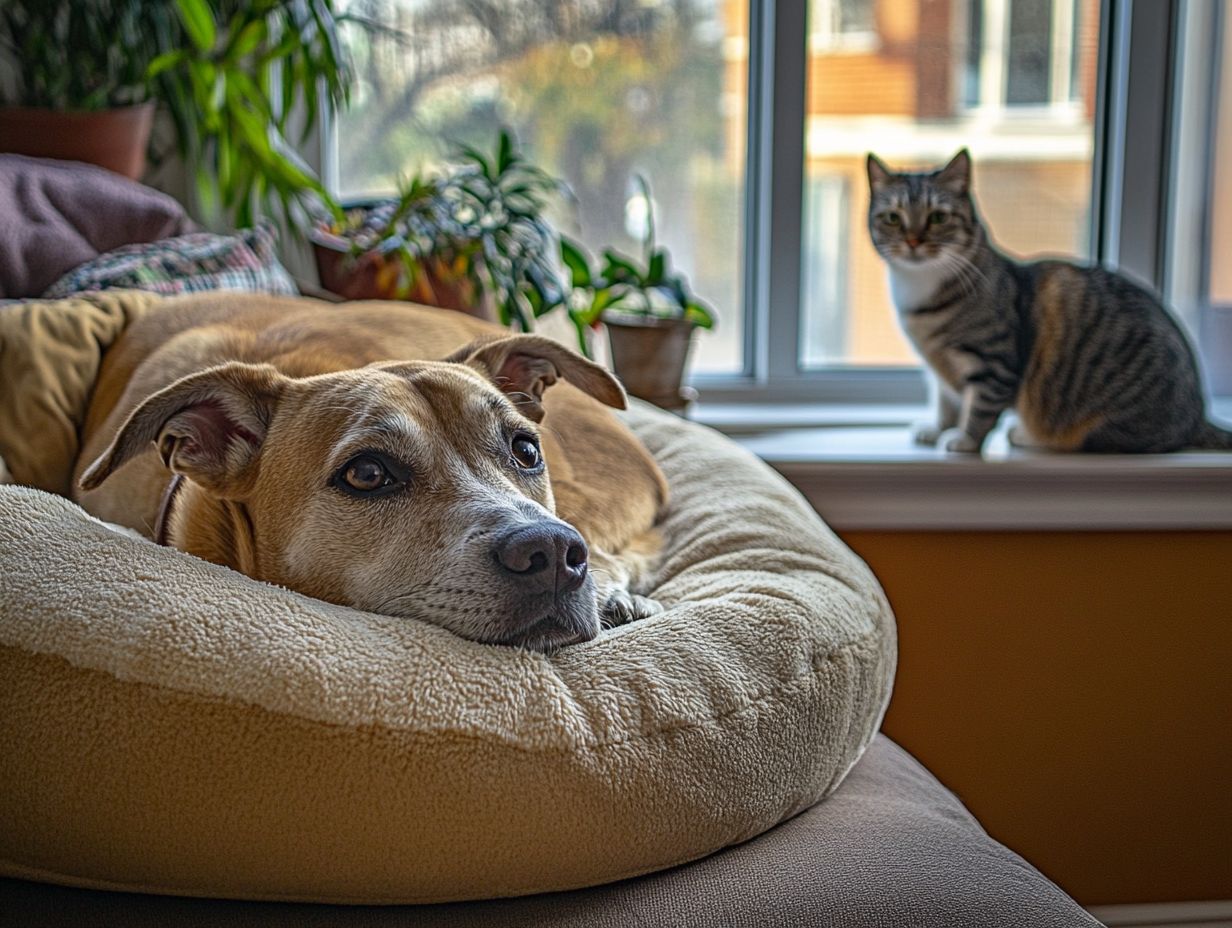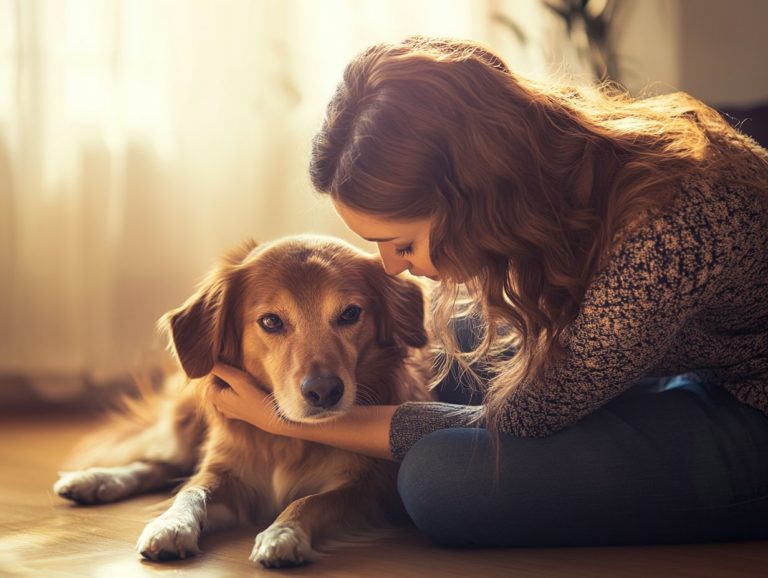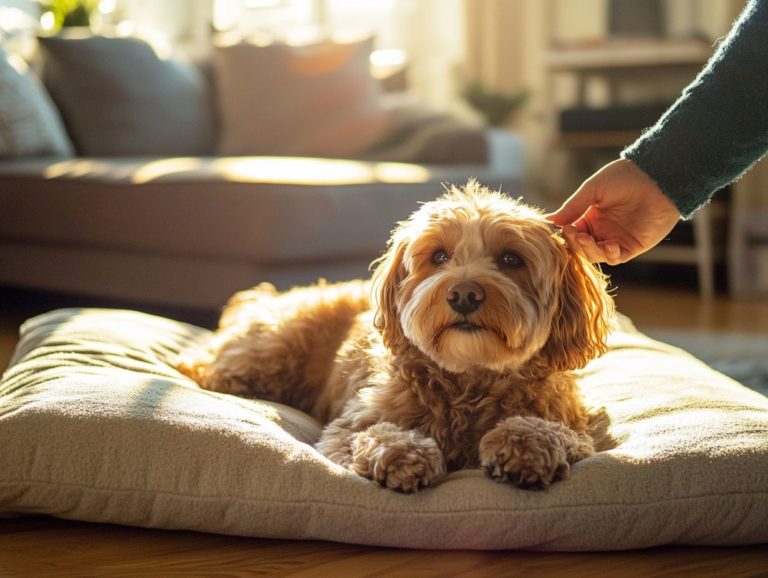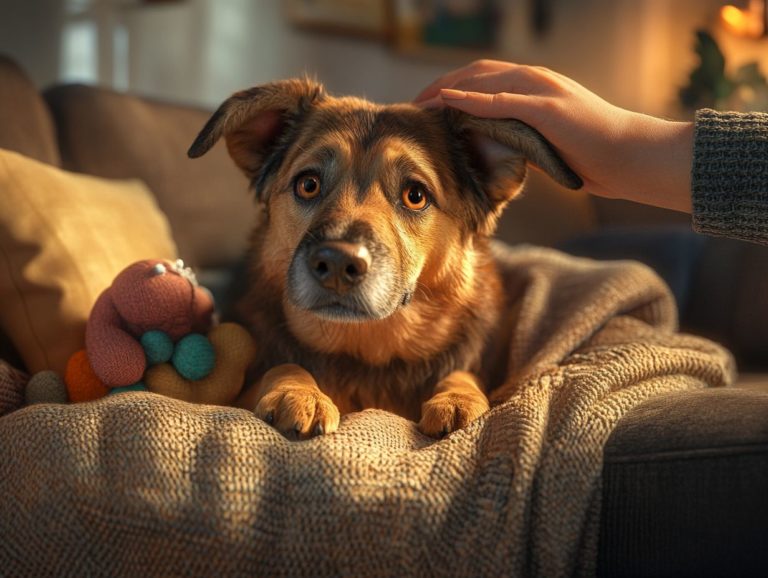Understanding the Anxiety Spectrum in Pets
Pet anxiety has become an increasingly pressing concern for many pet owners, directly impacting the well-being of your beloved furry companions. Spotting the signs of pet anxiety is the first step to helping your furry friend feel better!
Recognizing these signs whether they manifest as behavioral changes or physical symptoms is essential for delivering the proper care they deserve. This exploration delves into the spectrum of pet anxiety, its underlying causes, effective management strategies, and various therapeutic options available.
We will also share valuable tips for preventing anxiety, fostering a healthier and happier life for your pet. Engage with us as we unveil the essentials of understanding and addressing pet anxiety.
Contents
Key Takeaways:

- Recognize the signs of pet anxiety, including behavioral and physical indicators, to better support your furry friend’s mental health.
- Create a calming and secure environment for your pet, as environmental and psychological factors can contribute to anxiety.
- With the right strategies, techniques, medications, and therapies, pet anxiety can be effectively managed and even prevented to promote a happier, healthier pet.
What is Pet Anxiety?
Pet anxiety, especially in dogs, is an emotional state that surfaces when your furry friend feels overwhelming fear or worry. This condition can arise from various factors, such as separation anxiety when they are left alone or fear-related anxiety triggered by loud noises or unfamiliar environments. Age-related confusion in dogs can also affect older pets. Understanding the signs of chronic anxiety in pets is crucial for your dog’s happiness—act now to help!
Different dog breeds show varying levels of vulnerability to these types of anxiety. For example, loyal breeds like Labrador Retrievers may be more susceptible to separation anxiety. Similarly, high-energy breeds often experience heightened stress during thunderstorms or fireworks. Cognitive dysfunction, which commonly occurs in aging dogs, can further amplify these stress responses, leading to confusion and increased anxiety.
By identifying these anxiety triggers, you can take proactive steps to create a soothing environment, ultimately fostering better behavioral outcomes and enhancing your beloved companion’s quality of life. For more information, check out what you should know about anxiety in senior pets.
Signs and Symptoms of Pet Anxiety
Recognizing the signs and symptoms of pet anxiety is crucial for effective intervention and treatment. Common indicators include excessive barking, pacing, hiding, aggressive behavior, or destructive tendencies, each a reflection of your pet’s internal distress. For more insights, check out understanding the cost of pet anxiety experts.
Furthermore, understanding dog communication can empower you to identify these signs more clearly, enhancing your ability to implement better socialization and obedience training strategies that can alleviate anxiety.
Behavioral and Physical Indicators
Behavioral and physical indicators of pet anxiety can range from subtle whispers to loud alarms, making it essential for you as a dog owner to stay perceptive. Common signs of anxiety include excessive barking, destructive habits like chewing on furniture, and fear-driven behaviors such as trembling or cowering. By understanding these cues, you can enhance your communication with your dog, effectively addressing their needs and mitigating anxiety.
Recognizing anxiety early can profoundly impact your pet’s well-being. For example, if your dog consistently seeks refuge during loud noises or suddenly displays aggression toward other animals, these aren’t just quirky behaviors; they are red flags indicating discomfort. Understanding what to expect during a pet anxiety assessment can help you address these issues effectively.
You might also notice signs like excessive licking or pacing, which often indicate an attempt to cope with stress. By closely monitoring these signals, you can significantly improve your pet’s quality of life while nurturing a deeper bond built on trust and understanding.
For further resources or personalized advice, consider consulting your veterinarian. Together, we can ensure a happier, more comfortable life for your furry friend!
Causes of Pet Anxiety

Understanding the causes of pet anxiety is crucial for managing and intervening effectively. Factors contributing to your dog s anxiety can stem from both environmental and psychological sources.
Separation anxiety occurs when your pet is left alone. Additionally, aging-related anxiety can affect older dogs facing cognitive dysfunction syndrome, a condition impacting memory and thinking. Identifying these triggers is the essential first step in safeguarding your pet s emotional well-being and overall health.
Environmental and Psychological Factors
Environmental and psychological factors significantly influence the development of pet anxiety. They directly impact a dog s emotional well-being. Changes in routine, moving to a new home, or exposure to loud noises can trigger issues like separation anxiety or fear-related stress.
Psychological factors can also arise from past traumas or insufficient socialization. By understanding these influences, you can effectively mitigate anxiety in your dog.
For example, an abrupt change in your dog’s environment like welcoming a new family member or shifting your work schedule can create feelings of insecurity and stress. If your dog has a history of neglect or abuse, this background can exacerbate anxiety, particularly in situations that remind them of past traumas.
These factors often result in behaviors such as excessive barking, destructive chewing, or even aggression. Recognizing this complex interaction is vital. It enables you to create tailored strategies that cultivate a more secure and calm environment for your beloved furry friend.
Managing Pet Anxiety
Managing pet anxiety demands a comprehensive approach that weaves together various treatment methods and training strategies. Effective management often includes ways to change behavior, natural therapies like CBD oil, and enhancing your communication with your dog to create a secure environment.
By implementing proactive anxiety prevention strategies, you must pave the way for long-term success, enriching your dog s quality of life.
Effective Strategies and Techniques
Effective strategies and techniques for managing pet anxiety involve tailored approaches that cater to your pet’s unique needs. Training strategies can include obedience training and socialization, which enhance communication and understanding for your dog.
Don’t overlook the importance of natural therapies, such as regular exercise and proper nutrition, as they are critical in promoting overall well-being. By implementing anxiety prevention measures, you can significantly reduce the chances of anxiety disorders developing in your pets.
Incorporating regular socialization opportunities, like playdates or trips to dog parks, allows your pet to navigate new environments and interactions, ultimately reducing fear-based reactions.
Alongside these training methods, consider introducing calming natural therapies like CBD oil, which can effectively complement traditional approaches.
Consistency in exercise is essential not only does it contribute to physical health, but it also releases pent-up energy that could exacerbate anxiety. A well-balanced diet rich in essential nutrients is equally vital. It supports cognitive function and fosters emotional stability, helping your pet maintain a relaxed and balanced state of mind.
Treating Pet Anxiety

Addressing pet anxiety often requires a thoughtful blend of professional veterinary guidance and customized anxiety medications to suit your dog’s unique requirements.
Options like fluoxetine, clomipramine, benzodiazepine, and selegiline can be instrumental in managing anxiety disorders, especially for pets displaying significant behavioral challenges.
As a dog owner, it s important to engage with your veterinarian to craft the most effective treatment plan tailored to your furry companion’s needs. Consult your veterinarian today to discuss the best options for your dog.
Medications and Therapies
Medications and therapies for addressing pet anxiety offer a diverse array of options tailored to meet various needs.
Anxiety medications like fluoxetine and clomipramine can deliver quick relief. Natural therapies, such as exercise and proper nutrition, play a pivotal role in fostering long-term emotional well-being.
Consulting with a veterinarian is essential to achieve the right balance of treatments customized for specific behavioral concerns.
Each option holds a distinct place within a complete treatment plan, making it crucial to grasp how they interact. For example, integrating calming supplements like L-theanine with prescribed medications can bolster effectiveness without introducing unwanted side effects.
Establishing a consistent routine that includes daily physical activity can significantly alleviate symptoms. Regular walks or play sessions not only divert your pet’s attention but also instill a sense of security.
By collaborating closely with a veterinarian, you can create a tailored plan that harmonizes the benefits of both traditional and alternative therapies, ensuring your furry companions receive holistic care while keeping anxiety at bay.
Preventing Pet Anxiety
Preventing pet anxiety is a proactive endeavor that demands your consistent commitment to fostering your dog’s overall well-being.
Taking steps to prevent pet anxiety is not just important; it s essential for your dog s happiness and health! Implementing effective strategies is key; regular exercise and balanced nutrition play pivotal roles in supporting your pet’s mental health.
Strong communication with your dog and thoughtful training techniques can significantly reduce the risk of future anxiety-related issues. By prioritizing these practices, you re not just enhancing your pet’s quality of life; you re ensuring a happier, healthier companion.
Tips for Reducing Stress and Promoting Mental Health in Pets
Reducing stress and promoting mental health in pets is entirely within your reach through a variety of practical tips and techniques.
Consistent exercise and proper nutrition form the foundation of anxiety prevention, while effective communication with your dog cultivates a supportive environment.
Implementing training strategies that emphasize socialization also plays a crucial role in enhancing your pet’s emotional well-being.
For dog owners like you, establishing a routine can significantly foster a sense of stability and security.
Regular walks, engaging play sessions, and interactive toys can work wonders in alleviating anxiety.
Nutrition is equally vital; a balanced diet rich in essential vitamins and minerals can positively influence your pet’s mood and behavior.
By communicating with your dog using positive reinforcement rewarding good behavior you build trust and understanding, ensuring they feel more at ease.
Socialization goes beyond just meeting new dogs; exposing your pet to diverse environments and people helps build confidence and resilience, effectively reducing stress levels.
Frequently Asked Questions

What is the anxiety spectrum in pets?
The anxiety spectrum in pets refers to the range of different anxiety disorders that can affect animals, including separation anxiety, noise phobia, and general anxiety. Understanding these conditions and the needs of anxious pets is crucial for effective management.
It is important for pet owners to understand this spectrum in order to recognize and address signs of anxiety in their own pets, including the effects of age on pet anxiety.
What are some common signs of anxiety in pets?
Some common signs of anxiety in pets include excessive barking, destructive behavior, hiding, panting, and trembling.
These behaviors can be triggered by a variety of factors, such as loud noises, changes in routine, or being left alone for extended periods of time.
How can I help my pet cope with anxiety?
There are several ways to help your pet cope with anxiety, including creating a safe and calm environment, providing plenty of exercise and mental stimulation, and seeking professional help from a veterinarian or animal behaviorist.
It is important to address anxiety in pets, as it can lead to health issues and affect their overall well-being. For insights on this topic, consider exploring understanding the role of diet in pet anxiety.
Can anxiety in pets be treated?
Yes, anxiety in pets can be treated with a combination of behavior modification techniques, medication, and environmental modifications.
Your veterinarian or animal behaviorist can work with you to develop a tailored treatment plan for your pet’s specific anxiety disorder.
For personalized advice, consult your veterinarian today!
Can anxiety in pets be prevented?
Some pets may inherit traits that make them anxious. However, pet owners can take steps to prevent anxiety.
Start socializing (getting pets used to different people and environments) and training your pet from a young age. Maintain a consistent routine and provide a stimulating environment.
Is anxiety in pets the same as in humans?
Humans and animals both experience anxiety, but their causes and triggers can differ. The symptoms can be similar, and treatment methods often overlap.
Pet owners must recognize that their furry friends can experience anxiety. Understanding the timeline of pet anxiety treatment and getting professional help can make a world of difference!






